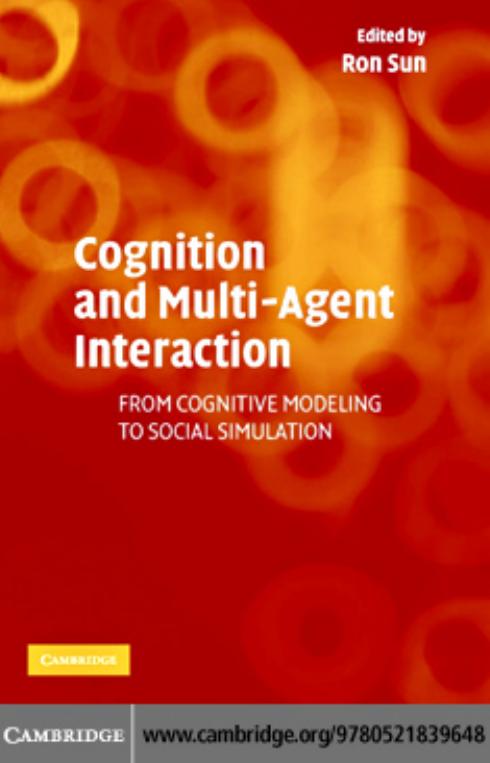Cognition and Multi-Agent Interaction: From Cognitive Modeling to Social Simulation by RON SUN (edt)

Author:RON SUN (edt)
Language: spa
Format: mobi, pdf
Tags: TEAM DDU
Published: 2006-01-21T10:07:08+00:00
226
Jonathan Gratch, Wenji Mao, and Stacy Marsella
figure 9.3. An example causal interpretation.
Each event is appraised in terms of several appraisal variables by domain-independent functions that examine the syntactic structure of the causal interpretation:
r Perspective: from whose perspective is the event judged r Desirability: what is the utility of the event if it comes to pass, from the perspective taken (i.e., does it causally advance or inhibit a state of some utility)
r Likelihood: how probable is the outcome of the event
r Causal attribution: who deserves credit or blame (i.e., what entity performed the action leading to the desirable/undesirable outcome) r Temporal status: is this past, present, or future
r Controllability: can the outcome be altered by actions under control of the agent whose perspective is taken
r Changeability: can the outcome be altered by some other causal agent Each appraised event is mapped into an emotion instance of some type and intensity, following the scheme proposed by Ortony, Clore, and Collins (1988). A simple activation-based focus of attention model computes a current emotional state based on most-recently accessed emotion instances.
Coping determines how one responds to the appraised significance of events. Coping strategies are proposed to maintain desirable or overturn undesirable in-focus emotion instances. Coping strategies essentially work in the reverse direction of appraisal, identifying the precursors of emotion
Modeling Social Emotions and Social Attributions 227
in the causal interpretation that should be maintained or altered (e.g., beliefs, desires, intentions, expectations). Strategies include: r Action: select an action for execution
r Planning: form an intention to perform some act (the planner uses such intentions to drive its plan generation)
r Seek instrumental support: ask someone who is in control of an outcome for help
r Procrastination: wait for an external event to change the current circumstances
r Positive reinterpretation: increase utility of positive side-effect of an act with a negative outcome
r Resignation: drop a threatened intention
r Denial: lower the probability of a pending undesirable outcome r Mental disengagement: lower utility of desired state
r Shift blame: shift responsibility for an action toward some other agent r Seek/suppress information: form a positive or negative intention to monitor some pending or unknown state
Strategies give input to the cognitive processes that actually execute these directives. For example, planful coping will generate an intention to perform the âjoin clubâ action, which in turn leads to the planning system to generate and execute a valid plan to accomplish this act. Alternatively, coping strategies might abandon the goal, lower the goalâs importance, or re-assess who is to blame.
Not every strategy applies to a given stressor (e.g., an agent cannot engage in problem-directed coping if he or she is unaware of an action that has an impact on the situation), however, multiple strategies can apply.
EMA proposes these in parallel but adopts strategies sequentially. EMA adopts a small set of search control rules to resolve ties. In particular, the model prefers problem-directed strategies if control is appraised as high (take action, plan, seek information), procrastination if changeability is high, and emotion-focus strategies if control and changeability is low.
In developing
Download
Cognition and Multi-Agent Interaction: From Cognitive Modeling to Social Simulation by RON SUN (edt).pdf
This site does not store any files on its server. We only index and link to content provided by other sites. Please contact the content providers to delete copyright contents if any and email us, we'll remove relevant links or contents immediately.
The Art of Thinking Clearly by Rolf Dobelli(10324)
Mindhunter: Inside the FBI's Elite Serial Crime Unit by John E. Douglas & Mark Olshaker(9263)
Change Your Questions, Change Your Life by Marilee Adams(7684)
Nudge - Improving Decisions about Health, Wealth, and Happiness by Thaler Sunstein(7657)
Mastermind: How to Think Like Sherlock Holmes by Maria Konnikova(7278)
The Power of Now: A Guide to Spiritual Enlightenment by Eckhart Tolle(5680)
Men In Love by Nancy Friday(5192)
Altered Sensations by David Pantalony(5071)
Factfulness: Ten Reasons We're Wrong About the World – and Why Things Are Better Than You Think by Hans Rosling(4713)
The Confidence Code by Katty Kay(4220)
Thinking in Bets by Annie Duke(4185)
Man and His Symbols by Carl Gustav Jung(4095)
The Worm at the Core by Sheldon Solomon(3450)
Why Buddhism is True by Robert Wright(3423)
Liar's Poker by Michael Lewis(3413)
Three Women by Lisa Taddeo(3393)
The Inner Life of Animals by Peter Wohlleben(3285)
Descartes' Error by Antonio Damasio(3248)
How Music Works by David Byrne(3234)
